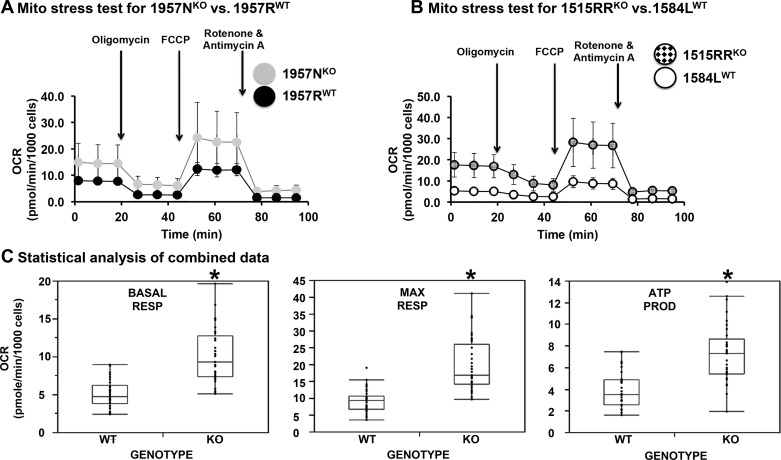Fig. 7.
Loss of nuclear matrix protein 4 (Nmp4) enhances mitochondrial respiratory capacity. The line graphs show a comparison of wild-type (WT) versus Nmp4−/− mesenchymal stem/progenitor cell (MSPC) oxygen consumption rate (OCR) profiles that have undergone the mitochondrial stress test. A: the MSPCs 1957RWT and 1957NKO were derived from male littermates. B: the MSPCs 1584LWT and 1515RRKO were derived from a random pair of male WT and Nmp4−/− mice. These graphs are representative of 5 individual tissue culture experiments (biological replicates). C: these graphs represent data from 5 separate experiments with cells from 5 different platings. In each experiment, 10 technical replicates with each cell preparation have been performed. The data are means ± SD. Statistical significance was set at P < 0.05. Basal respiration (BASAL RESP) was first measured, and then, the cells were sequentially exposed to various inhibitors of the mitochondrial electron transport chain. ATP production (ATP PROD) was based on the comparison between the basal OCR and the oligomycin-induced drop in OCR. The subsequent injection of carbonyl cyanide-4(trifluoromethoxy)phenylhydrazone (FCCP) uncoupled the electron transport chain increasing OCR and permitting the calculation of the maximal respiration rate (MAX RESP). Nonmitochondrial respiration was determined from the final injection of rotenone, a complex I inhibitor, and antimycin A, a complex III inhibitor. This parameter was significantly higher in the Nmp4−/− cells (data not shown). Spare respiratory capacity was also significantly elevated (data not shown).

